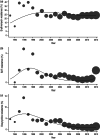Progressive increase in community-associated methicillin-resistant Staphylococcus aureus in Indigenous populations in northern Australia from 1993 to 2012
- PMID: 25302939
- PMCID: PMC9507213
- DOI: 10.1017/S0950268814002611
Progressive increase in community-associated methicillin-resistant Staphylococcus aureus in Indigenous populations in northern Australia from 1993 to 2012
Abstract
Hospital-based studies have determined high rates of community-associated methicillin-resistant Staphylococcus aureus (MRSA) in Indigenous populations. However, there is a paucity of community-based data. We obtained 20 years (1993-2012) of data on S. aureus isolates (N = 20 210) collected from community clinics that provide services for Indigenous communities in the Northern Territory, Australia. Methicillin resistance increased from 7% to 24%, resistance to macrolides remained stable at ~25%, and there was a slight increase in resistance to trimethoprim-sulfamethoxazole. The increase in methicillin resistance is concerning for the Indigenous communities represented by this data, but it is also of significance if virulent MRSA clones emerge and spread more widely from such settings.
Keywords: trimethoprim-sulfamethoxazole.
Conflict of interest statement
None.
Figures


References
-
- World Health Organization. Antimicrobial resistance: global report on surveillance (http://www.who.int/drugresistance/documents/surveillancereport/en/), 2014. Accessed 19 May 2014.
-
- Udo EE, Pearman JW, Grubb WB. Genetic analysis of community isolates of methicillin-resistant Staphylococcus aureus in Western Australia. Journal of Hospital Infection 1993; 25: 97–108. - PubMed
-
- Tong SY, et al. Community-associated strains of methicillin-resistant Staphylococcus aureus and methicillin-susceptible S. aureus in Indigenous northern Australia: epidemiology and outcomes. Journal of Infectious Diseases 2009; 199: 1461–1470. - PubMed
MeSH terms
Substances
LinkOut - more resources
Full Text Sources
Other Literature Sources
Medical

